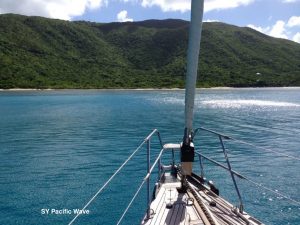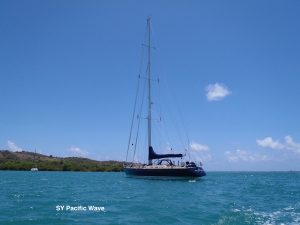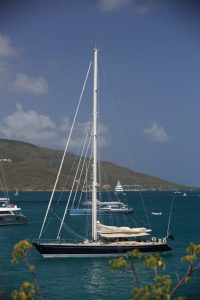Safely Anchoring Pacific Wave
Pacific Wave rests calmly at anchor every night. Other than making it convenient to board or disembark with bags at the beginning and end of your vacation, or in a storm, we just don’t see how you can have a great Caribbean charter if you are tied to the dock in a noisy, smelly, busy, and expensive marina. Instead we have dinner under the stars, a fresh cooling breeze flowing through the boat, and we are always close to a great snorkel spot for an early morning swim before breakfast. Anchoring, however, is an art and how we do it is one of the most frequently asked questions onboard Pacific Wave. We are at anchor over three hundred nights a year and are now into our ninth year in the BVI. We have picked up a few tips we’d be happy to share.

Pacific Wave anchored off Guana Island time for a morning swim.jpg
Know your bottom.
The sea bed isn’t the same everywhere. Some bays have excellent holding in silt, some good in soft sand, some poor on slippery fine coral rock. Some bays have obstructions, often shown on navigation charts but sometimes not. There are hidden rocks and coral heads, or uncharted wrecks to snag. In North Sound off the Bitter End Yacht Club there are power cables which you really don’t want to drag. At Peter Island in Great Harbour there is an un-marked private hurricane mooring, a thick rope buried in the sand and impossible to see – but you’d know it if you found it. We are familiar with them all. Needless to say the best place to drop the hook is often in the deeper water. Due to the topography in the BVI this can be surprisingly close to shore. For us deeper water means over 60 feet. This is a typical depth for us in all the bays we are likely to visit in the BVI. For us it means that it is important to…..

SY Pacific Wave anchored in North Sound with a silty sea bed
Know your tackle.
Pacific Wave is a heavy boat. Our Gross Weight is registered at over 56 tons but she’s probably put on a few pounds over the years. As part of our licensing, which we call Coding, we are inspected every year by a marine surveyor to verify that we still have the correct size of chain and weight of anchor to ensure trouble-free anchoring. For those interested in the detail we have over 400 feet of 1/2 inch high test chain attached to a 110 lb CQR anchor. We have additional anchors attached to chain and warp for storm conditions. They are carried onboard for safety but we’ve never needed them. People do wonder how a 100 lb anchor can hold a 100,000 lb boat. The answer is it doesn’t. The boat isn’t held by the weight of the anchor but by the friction of the chain on the seabed. Think of it as if the anchor holds the chain, and the chain holds the boat. Crucial to this of course is putting out the right length of chain.

SY Pacific Wave anchored off Long Bay Virgin Gorda BVI sandy bottom
Know that it is long enough.
The rule of thumb is to put out a minimum of 4 times the depth. In 60 feet of water we would put out nearly 250 feet of chain. Usually we add a bit to this. If we know that the wind is forecast to increase in the night we may put out 5 or 6 times the depth, or if the holding is poor we’ll also put out more chain. To enable us to do this we communicate from the front to the back of the boat by radio to know the depth under the keel at our anchor spot. The chain is marked every 30 feet with colour coded markers so we know when the correct amount is in the water.

Pacific Wave anchored North Sound BVI
Be safe.
The art of anchoring is often picturing in your head where you may end up, where you’ll swing if the conditions change, and how that interacts with other boats in the anchorage to ensure you don’t end up too close to each other. All we can say is, we have enough experience to visualise this, and also when to be aware of other boats anchoring after us if they aren’t as experienced. Very occasionally we may need to have a polite word with other boats if it appears they are anchoring without being able to visualise it! When the boat has settled we attach a snubbing line, a thick strong rope with a hook on the end, which transfers the pulling load on the chain from the anchor windlass directly to a strong cleat on the deck. This takes some of the shock load away from the windlass and its expensive gearbox. We hoist an anchoring day shape on the bow, a black ball, and a white night light to tell others that we are at anchor. Finally, we set an alarm on the GPS to tell us if we are moving.

SY Pacific Wave anchored in the Virgin Islands
After all of that you can rest easy with a sundowner knowing that the crew are responsible and experienced at anchoring. Taking care of you is their number one priority.

SY Pacific Wave anchored off BEYC BVI



